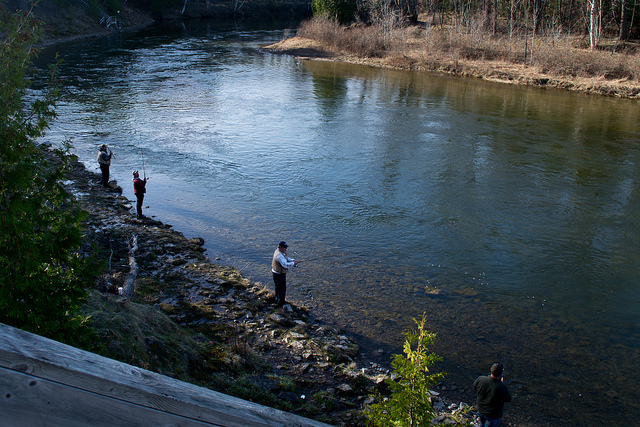Tension on Au Sable and Manistee rivers
To hear Anglers of the Au Sable First Vice President Tom Baird tell it, the Au Sable and Manistee Rivers, which flow east and west, respectively, from their headwaters north of Grayling, boast some of the most pristine recreational waters in the state. Trout fishermen flock here every spring and stake out angling spots in the “Holy Waters,” an 8.7-mile stretch of the Au Sable known for its wadeable water, dependable insect hatches and quality trout fishing.
Last October, the Michigan Department of Natural Resources approved the lease of property along the Holy Waters for oil and gas development, raising the specter of hydraulic fracturing, or fracking, wells next to the trout stream. The Anglers of the Au Sable cried foul and launched a campaign that American Angler magazine dubbed the “holy wars.” In response, DNR director Keith Creagh in December changed the leases along the Holy Waters to prohibit above ground development.
“We can accomplish our oil and gas management goals in this corridor without surface development,” Creagh said at the time. “Advances in technology allow us to limit surface use. We look forward to working with citizens to identify special places where surface development should be limited.”
Doug Hock, Encana’s director of community and public relations, held out the option that the company could still use horizontal drilling to access mineral resources near the river.
“We have a good working relationship with DNR and Department of Environmental Quality (DEQ),” said Baird, “but we are critical of some of their efforts… We see a need to remain vigilant with respect to actions of industry, the DNR and DEQ.”
There have been other tensions between the Anglers and Encana. In 2011, a north branch of the Manistee River near Grayling nearly dried up; the Anglers claim Encana’s fracking operation nearby was the culprit. Encana has also pushed for new frack pads carrying multiple wells near the Manistee and Au Sable headwaters.
The Anglers’ concerns about fracking have evolved from the chemicals and risks of pollution to the amount of fresh water used — potentially as much as 35 million gallons per well, according to a study of permit applications.
“We’re starting to learn that the possibility of pollution from two miles underground is fairly low,” said Baird. “The big issue is water use. They’re pulling fresh water from nearby aquifers to the surface. That causes a drawdown of the aquifer, and can have an adverse effect on streams and rivers and their flow.”
Business Watch
Covering the intersection of business and policy, and informing Michigan employers and workers on the long road back from coronavirus.
- About Business Watch
- Subscribe
- Share tips and questions with Bridge Business Editor Paula Gardner
Thanks to our Business Watch sponsors.
Support Bridge's nonprofit civic journalism. Donate today.
See what new members are saying about why they donated to Bridge Michigan:
- “In order for this information to be accurate and unbiased it must be underwritten by its readers, not by special interests.” - Larry S.
- “Not many other media sources report on the topics Bridge does.” - Susan B.
- “Your journalism is outstanding and rare these days.” - Mark S.
If you want to ensure the future of nonpartisan, nonprofit Michigan journalism, please become a member today. You, too, will be asked why you donated and maybe we'll feature your quote next time!


 The Anglers of Au Sable have campaigned against oil and gas development near the Blue Ribbon trout stream. (Photo by Flickr user Arvind Govindaraj; used under Creative Commons license)
The Anglers of Au Sable have campaigned against oil and gas development near the Blue Ribbon trout stream. (Photo by Flickr user Arvind Govindaraj; used under Creative Commons license)